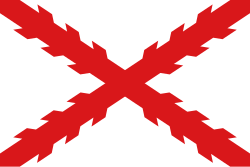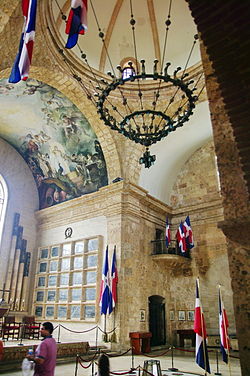Description
As described by Article 21 of the Dominican Constitution, the flag features a centered white Saint George's Cross that extends to the edges and divides the flag into four rectangles; the top ones are blue (hoist side) and red, and the bottom ones are red (hoist side) and blue. The national coat of arms, featuring a shield with the flag, design and supported by a bay laurel branch (left) and a palm frond (right), is at the center of the cross. [2] Above the shield, a blue ribbon displays the national motto Dios, Patria, Libertad (English: God, Homeland, Liberty). Below the shield, the words República Dominicana appear on a red ribbon (this red ribbon is depicted in more recent versions as having its tips pointing upward). In the center of the shield, flanked by three spears (two of them holding Dominican banners) on each side, is a Bible with a small Latin cross above it and said to be opened to the Gospel of John, chapter 8, verse 32, which reads Y la verdad os hará libres (And the truth shall make you free). [2] It is one of 28 national flags to contain overtly Christian symbols. [6]

Color scheme | Blue | Red | White |
|---|
| RGB | 0,45,98 | 206,17,38 | 255,255,255 |
| Hexadecimal | #002D62 | #CE1126 | #FFFFFF |
| CMYK | 100 - 54 - 0 - 62 | 0 - 92 - 82 - 19 | 0 - 0 - 0 - 0 |
History
The island of Hispaniola in the Greater Antilles of the Caribbean was discovered by explorer Christopher Columbus during his first voyage on December 5, 1492. Landing on the northwestern coast of the island in present day Haiti, he established La Navidad, the first European settlement in the Americas. During his second voyage in 1493, he established La Isabela, the first stable European settlement in the Americas, on the north-central coast of the island in present day Dominican Republic, after La Navidad was destroyed by the native Taíno people.
Sponsored by the Catholic Monarch of Spain, Columbus claimed Hispaniola for the Spanish Empire, the first European power to conquer and colonize the island. Concentrated in the eastern part of the island, the Spanish established the colony of Santo Domingo and its eponymous capital, the city of Santo Domingo, by 1496. After the Devastations of Osorio in 1605, the western part of the island was depopulated, facilitating the establishment of the colony of Saint-Domingue by the French Empire, beginning with the settlements of Tortuga in 1659 and Cap-Haïtien in 1670.
After the Haitian Revolution, which successful fought against France to establish the First Empire of Haiti, the first independent country in Latin America, in 1804. After the overthrow of the Haitian elective monarchy, the flag of Haiti was adopted by the succeeding Republic of Haiti in 1806. Featuring the coat of arms of the country over a blue and red horizontal stripe, the Haitian flag was based on the flag of France, a vertical tricolor of blue, white, and red adopted during the French Revolution against its ancien régime or absolute monarchy in 1794.
After gaining independence as the Republic of Spanish Haiti in 1821, the eastern colony of Santo Domingo was soon occupied and annexed by the Haitians, uniting the entire island of Hispaniola as the Republic of Haiti from 1822 to 1844. With the establishment of revolutionary organization of La Trinitaria in 1838, which successfully fought against Haiti to liberate Santo Domingo as the independent First Dominican Republic, the flag of the country was first introduced. It featured a centered white cross, like the regimental flags of the Kingdom of France, over a horizontal blue stripe on top and red stripe on the bottom, like the flag of Haiti.
Designed by Juan Pablo Duarte, the Father of the Nation, it was first hoisted on February 28, 1844, the day after the beginning of the Dominican War of Independence against the Haiti. [7] The ultramarine blue represented the protection of God over the country. The vermillion red color represented the blood shed by the patriots in the struggle for freedom of the country. The white cross in the center symbolized the peace and unity of the people of the country, Dominicans. [8] The first flags were made by María Trinidad Sánchez, María de Jesús Pina, Isabel Sosa and Concepción Bona.
The flag was used until the annexation of the Dominican Republic into the Spanish Empire from 1861 to 1865, during which period it was replaced by the flag of Spain. With the restoration of independence as the Second Dominican Republic, the flag was reintroduced with some changes. The coat of arms of the country was placed in the center of the flag at the intersection of the white cross, like the flag of Haiti. The position of the blue and red quarters on its fly side was also flipped, creating an alternating pattern, like the French regimental flags. The addition of the coat of arms, which consists of a bible opened to John 8:31–32 above a cross and the motto Dios, Patria, Libertad (God, Fatherland, Liberty), further reflected the Christian ideals of Duarte.
This page is based on this
Wikipedia article Text is available under the
CC BY-SA 4.0 license; additional terms may apply.
Images, videos and audio are available under their respective licenses.



































